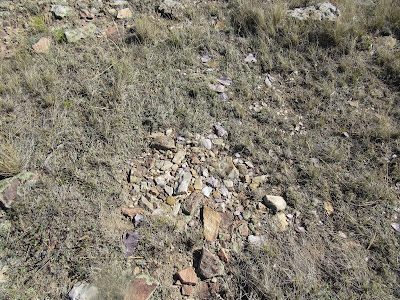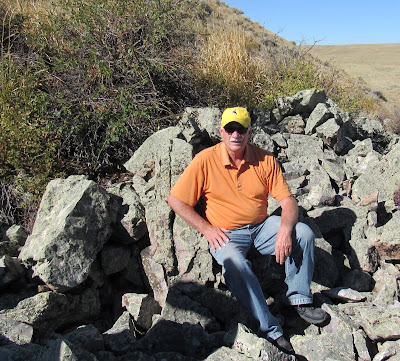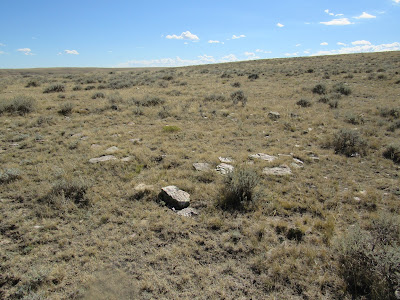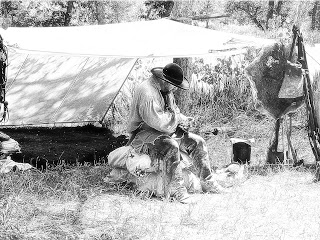I taught History of the American West and Wyoming History for more than 40 years and during that time attempted to visit as many of the places we studied as I could. Last Saturday, for the first time, I was able to take a trip to the Spanish Diggings, a site rich in hard quartzite rock used by ancient people. My first impression of the area is that it is spectacular, and the dig sites are incredible.
The area lies between Guernsey and Lusk in both Platte and Niobrara counties in a remote and difficult to reach area. The major section of the site was deeded to the state many years ago, but the only way to reach this valuable resource is by crossing private land on a rough two track in an area of wheat strips.
Thanks to Patsy Parkin, President of the Platte County Historical Society, a group of 40 of us spent a memorable day going through the site. Our tour was led by Randy Brown of Douglas, a man who has taken numerous groups through the site. Mr. Brown took our group to the Barber Site and the Dorsey Quarry #2, along with other unnamed areas.
 |
| Here we are - ready to take a look at the Diggings |
The Spanish Diggings may be as old as 10,000 years or more. Some believe 5,000 years is closer, and some think the digs date back a mere 1,000 years. Although what year they started might never be known, we do know, the rock quarries at the site were likely not abandoned until trade goods made of iron reached the area. This would mean that the site, used for centuries, has been unused since the early or middle of the 1800s when the first trapper/traders reached the area.
 |
| Part of the rock quarries at the Barber Site |
Broken Rock Everywhere
Not only are the dates of use a mystery, but how the large rock outcroppings were worked is also a mystery. Dozens of huge fields of broken rock can be found in an area of 400 square miles, smaller rock; some worked on two or more edges can be found strew about for miles in every direction.
 |
| Worked pieces of stone litter the landscape for miles |
The size of many of the broken pieces, some half the size of a living room recliner and thousands the size of basketballs, leads me to believe that they had more knowledge of levers, and physics than most believe.
 |
| Taking a break on rock broken thousands of years ago. |
Who Built It?
Early visitors to the sites dismissed the idea of the Plains Indians having anything to do with the diggings. Odd, because we now know that they are the very people that built and used the dig sites for at least one hundred generations. Locals and experts, more than one hundred years ago, saw the diggings as something taking more knowledge than the primitive peoples of the Plains and Mountains could possibly have acquired. How these first visitors explained the teepee rings in the area has not been recorded. What was their theory if it was not the first peoples of the area? They came up with an idea far more bizarre. They believed it was the Spanish, the Conquistadors. The fact that none came within hundreds of miles of Wyoming and the additional fact, if it were the Conquistadors, they would have needed to stay for years seems to let that idea pass by common sense. But the name stuck – the Spanish Diggings.
 |
TeePee Ring - More than one hundred years ago a historian/archeologist
visiting the site found a quarter section of land where "A man could not walk
50 feet in any direction without standing in a teepee ring." |
So what do we know? First, the diggings were a project of native Indians of the plains, possibly before they were divided into modern tribal distinctions. Another thing we know is that it was not a project of short duration as evidenced by the hundreds, more likely, thousands of teepee rings in the area.
Two great mysteries remain. The first of these is the most puzzling, nowhere on the site has anyone discovered a fire pit or anything resembling a cooking site. Second, in modern time there is no water at the site. There are several dry stream beds in the area that may have been more active hundreds or thousands of years ago as running water or at least spring runoff having left behind potholes of water.
A Park
When John B. Kendrick was governor of Wyoming (1915-1917) he proposed making the entire area a drive through national park. The governor’s idea died out with World War I but was brought up once again during the Great Depression. When the young men of the Civilian Conservation Corps were putting together what was to become Guernsey State Park under the careful watch and design of the National Park Service, there was talk of expansion to the Spanish Diggins. This time, the idea nearly became a project for the CCC, but as did the first idea, it died with war, World War II.
What did I learn?
Many things. If the Spanish Diggins go back as far as 10,000 or even 12,000 years, which is very possible, considering the absence of fire pits, the first stone workers were appropriately Stone-Age people. Stone Age people used primitive weapons and tools, arrowheads, spear points, hammers, and wedges. These people would have been from the Paleo-Indian culture, a nomadic hunting, and wandering people. They also show better than a rudimentary knowledge of hammers, wedges, use of levers, and an understanding of basic physics. Maybe they were more advanced than most people believe.
 |
| Taking a look |
It is more than likely that thousands of years later, during the Archaic Period, around 7,000 B.C. that stone was quarried in this local site. This was a period when stone weapons and stone tools were made by the tens of thousands by native peoples. From that time on, hundreds of generations used the Platte/Niobrara County site to mine the rich purple quartz.
 |
| The sought after rock - these have been worked a bit |
To almost borrow a line from an old Four Seasons, song –
Oh, What A Day!
 |
| Our view from the top of our hike through the Spanish Diggings |








